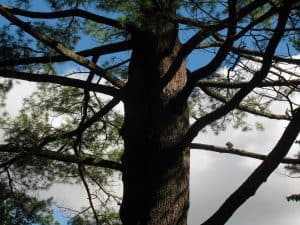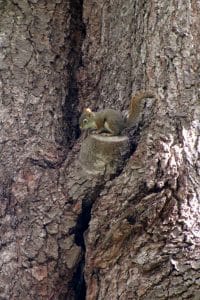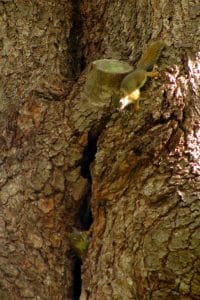Over the past ten years, we’ve seen a marked decline in the number of Red Squirrels and a steady increase in the number of Gray Squirrels on our property. This year that imbalance may change. For the first time that we are aware, we have had two broods of Red Squirrels rather than just the one.
Back in May, an adult Red Squirrel was seen transferring her young family from a birth site in one tree to a nest cavity in our signature tall White Pine. The trunk separates into two part well above ground level, possibly providing a more commodious home. By May 21, five young were darting back and forth from the nest, exploring their immediate surroundings. It was most entertaining!
By the last week of May, only one youngster was still staying close by the nest cavity when an adult female Gray Squirrel took possession of the nest with five of her own family, chasing off the one remaining Red Squirrel. Again we were entertained by the little ones running about the tree branches and eventually out exploring the surrounding landscape.
On September 6, a Red Squirrel with five young took possession of the same nest cavity. She spent some time gathering new nest material to refurbish the bedding, then possibly tired and hungry after her exertions, took a break to consume fallen sunflower seeds below a nearby bird feeder. (In all three cases the adult female had teats visible on her underside.)
For the third time, we enjoyed the antics of little ones chasing each other about the tree until they too abandoned the nest to make their own way in the world. On September 7, I was able to capture a few photos of the youngsters in the tree and close up at the cavity entrance.
Here’s hoping the survival rate is good.
Stephenie Armstrong, Warsaw


